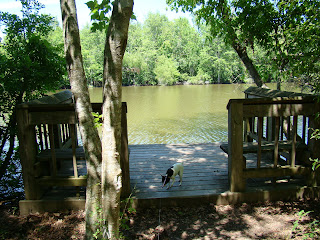May 5-8, 2011
We are in Lake Fausse Pointe State Park, LA, after a 14 mile dirt road entry along a man made levee.
Bayou Benoit Levee Rd.
Water to the left in back of trees; dirt mound levee to right.
We were surprised when the dirt road ended in a very civilized entry into the state park.
Checking in, Bill was asked how his trip had been. He replied, “OK, until those last 14 miles.” The ranger said, “You followed your GPS didn't you.” He then smiled broadly. It seems the longer route from town included eight miles from the north along the same levee but on paved road. Live and learn : )
Our site is on a bayou channel between lakes. We have our own little dock for sitting and fishing. Actually, we'll just be sitting. It is nicely shaded.
From our private dock (called wharf, here)
Upon arrival on Thursday, the park was almost empty. Only two other rigs were in sight. A woman started yelling for her dog T-Bit. “Come home right now!” She was looking directly at Isabel who was tied to the picnic table. T-Bit surprised the woman by arriving from behind her fifth wheel. She laughed and walked over to introduce us to Isabel's “twin brother” and herself. Her name was Charleane Boudin. (See Avery Island blog for more on boudin.)
T-Bit and Isabel enjoying a cookie
We have no cell phone coverage but powerful WiFi. Go figure! There is a walking trail that takes you out by a lake where there “may be” cell phone signals. We didn't try that.
It is quiet, lovely, serene...except for concern that an alligator could eat Isabel in one whomp. By Friday evening the park was full! In this flat area of the world, the preferred bicycle is a Schwinn with stand on brake. Men and boys also prefer the barless model. No need for gears here.
Wikipedia gave me a needed lesson on Bayou country:
A bayou (pronounced /ˈbaɪ.oʊ/ or /ˈbaɪjuː/) is a body of water typically found in flat, low-lying areas, and can refer either to an extremely slow-moving stream or river (often with a poorly defined shoreline), or to a marshy lake or wetland. Bayous are commonly found in the Gulf Coast region of the southern United States, particularly the Mississippi River region, with the state of Louisiana being famous for them. A bayou is frequently an anabranch or minor braid of a braided channel that is moving much more slowly than the mainstem, often becoming boggy and stagnant, though the vegetation varies by region. Many bayous are home to crawfish, certain species of shrimp, other shellfish, catfish, frogs, american crocodiles, american alligators, and a myriad other species.
The word was first used by the English in Louisiana and is thought to originate from the Choctaw word bayuk, which means "small stream."[1] The first settlements of Acadians in southern Louisiana were near Bayou Teche and other bayous,[2] which led to a close association of the bayou with Cajun culture.
Bayou Country is most closely associated with Cajun and Creole cultural groups native to the Gulf Coast region generally stretching from Houston, Texas, to Mobile, Alabama, and picking back up in South Florida around The Everglades with its center in New Orleans, Louisiana.
We drove thirty miles to town, on hard surfaced roads, and met two interesting locals. One man saw our license plate and said, good humoredly, “You all the folks sending us down those waters for a flood?” Seems the predicted time of arrival for the state park to be flooded is sometime next week. The Mississippi is having its own problem, but Bill read that all the streams that normally flow into the great river can't “fit” so have nowhere to go but over their banks. At the visitor center as we entered Louisiana we were told to avoid Vidalia, LA, as the visitor center there was evacuating and expecting 6 feet of water in their building “next week.” Bill has rerouted us.
The second person was a young man who shared the small waiting room at Wal-Mart's car center while we were each getting oil changes. Bill asked him for the correct spelling and pronunciation of the popular local crustaceans. Turns out the original word is crayfish but he explained, “We Cajuns [he actually used a very derogatory name for himself as a Cajun which I shall not repeat here] shortened everything and called 'em crawfish. We really call 'em mudbugs.” Bill and I saw only one sign in town offering mudbugs but lots selling CRAWFISH.
The young Cajun told us about local restaurants and Bill chose Clementine's in downtown New Iberia. The main street looks very much like old New Orleans. We thoroughly enjoyed a deeply shaded sidewalk table and celebrated the anniversary of our meeting.
Lunch at Clementine's in New Iberia, LA
When Bill and I were in New Brunswick, Canada, in 2000, we visited some areas where (according to Wikipedia) “[d]uring the French and Indian War, British colonial officers and New England legislators and militia executed the Great Expulsion of 1755-1763. They deported approximately 11,500 Acadians {formerly French] from the maritime region. Approximately one third perished from disease and drowning.” Some were returned to France but others landed in this area, St. Martin's Parish, Louisiana. The Acadians became known as Cajuns. This area's claim to fame is Where Cajun Began...







No comments:
Post a Comment